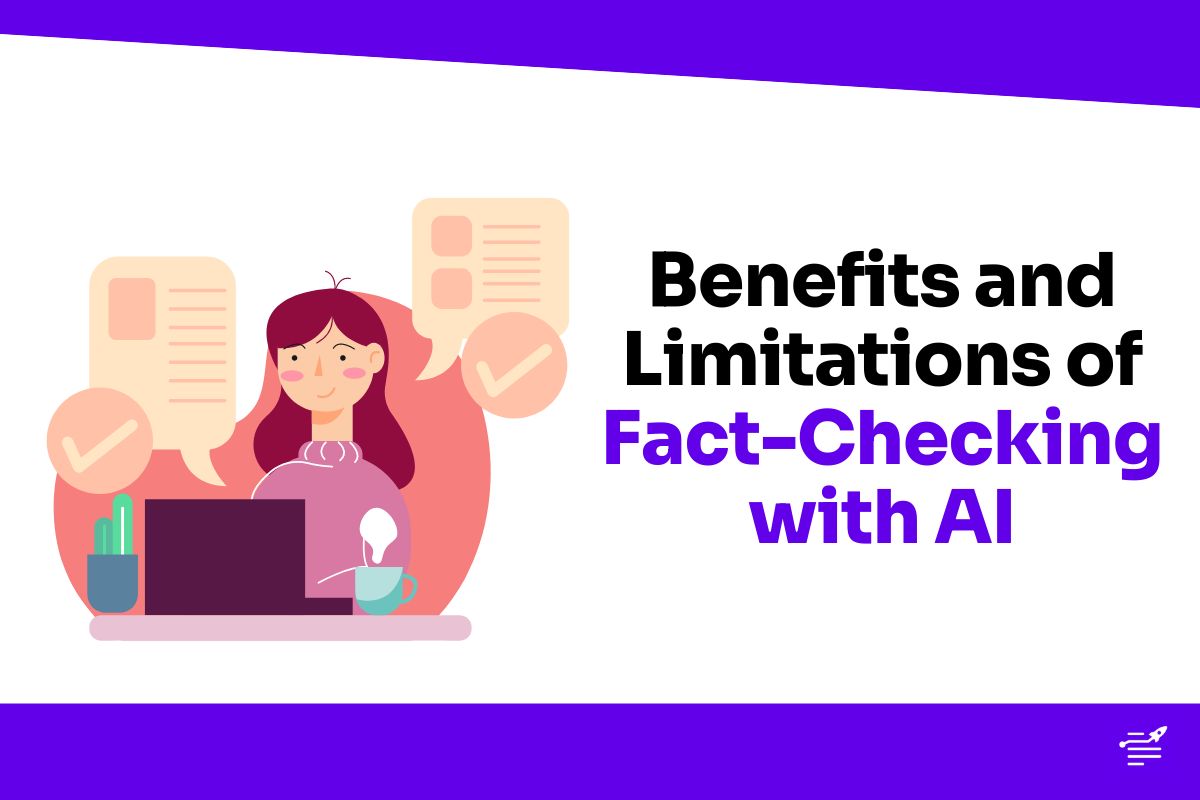As misinformation and fake news continue to permeate various aspects of society, the need for effective fact-checking has become more crucial than ever before. In recent years, there has been an increase in the use of artificial intelligence (AI) for fact-checking purposes.
While this technology offers several benefits, it also has its limitations. This blog post will explore the benefits and limitations of fact-checking with AI, how it works, examples of best AI fact-checking tools, and its future implications.

What is Fact-Checking with AI?
Fact-checking with AI involves using machine learning algorithms and natural language processing techniques to verify the accuracy of information. The technology aims to detect false or misleading claims and provide accurate information to the public.
Benefits of Fact-Checking with AI

Increased Speed and Efficiency
One of the key benefits of using AI for fact-checking is the increased speed and efficiency it provides. AI can process large volumes of data and identify potential false claims quickly and accurately, which would be difficult and time-consuming for humans to do.
This speed and efficiency mean that false information can be identified and debunked quickly before it spreads widely.
Reduced Bias
Human fact-checkers are susceptible to cognitive biases, such as confirmation bias, which can affect their ability to remain objective.
AI-based fact-checking systems, on the other hand, can eliminate these biases and provide a more objective analysis of the information.
Improved Coverage
AI-based fact-checking systems can scan vast amounts of data from different sources, including social media platforms, news articles, and blogs, to identify false claims.
This coverage means that AI can identify false information in a broader range of contexts and provide more comprehensive fact-checking than human fact-checkers.
How Fact-Checking with AI Works
Machine Learning and Natural Language Processing
Fact-checking with AI involves using machine learning algorithms and natural language processing techniques to analyze textual data. Machine learning algorithms enable the AI system to learn from past examples and improve its accuracy over time. Natural language processing techniques allow the AI to understand the nuances and complexities of human language, making it possible to detect false claims accurately.
Types of Fact-Checking with AI
Simple Fact-Matching
Simple fact-matching involves comparing a claim against a pre-existing database of factual information. If the claim matches an existing fact, it is considered true, and if it does not match, it is considered false.
This method is relatively straightforward but is limited to checking claims that have already been fact-checked and added to the database.
Complex Fact-Checking
Complex fact-checking involves analyzing the context and meaning of a claim to determine its accuracy. This method requires the AI system to understand the nuances and complexities of human language and the context in which the claim was made.
Complex fact-checking is more challenging than simple fact-matching but can detect false claims in a broader range of contexts.
Real-Time Fact-Checking
Real-time fact-checking involves analyzing live events, such as political debates or speeches, to identify false claims in real-time.
This method requires the AI system to process information quickly and accurately and provide instant feedback to the audience.
Limitations of Fact-Checking with AI
Dependence on Data Quality
Fact-checking with AI relies heavily on the quality of the data it analyzes. If the data is inaccurate or incomplete, the AI system may produce incorrect results. Additionally, if the data used to train the AI system is biased, this bias may be reflected in the system's output.
Inability to Detect Nuance and Context
AI systems may struggle to detect nuance and context in human language, which can lead to false claims being identified as true or vice versa. For example, an AI system may not understand sarcasm or irony, leading to false positives or negatives in its fact-checking results.
Susceptibility to Manipulation
AIsystems can be susceptible to manipulation by those who wish to spread false information. For example, bad actors may use adversarial examples – inputs that are specifically designed to mislead AI systems – to trick the system into identifying false claims as true or vice versa.
Ethical Concerns
Fact-checking with AI raises ethical concerns related to privacy, fairness, and transparency. For example, AI systems may inadvertently collect sensitive personal information while analyzing data or introduce biases that unfairly target certain individuals or groups.
Additionally, the algorithms used for fact-checking may be opaque, making it difficult to understand how the system arrived at its conclusions.
Combining Human Expertise with AI
Advantages of Human Oversight
While AI-based fact-checking systems offer several benefits, they are not infallible, and human oversight remains essential. Human fact-checkers can provide valuable insights that AI systems may miss, such as understanding complex context or detecting subtle nuances in language.
Additionally, humans can help ensure that AI systems operate ethically and transparently by monitoring their performance and addressing any biases or inaccuracies.
Challenges of Collaboration between Humans and AI
Collaboration between humans and AI in fact-checking presents several challenges. One challenge is ensuring that humans and AI systems effectively communicate and understand each other's outputs.
Another challenge is maintaining trust between human fact-checkers and AI systems, particularly when the AI system makes mistakes or operates in a non-transparent manner.
Examples of Fact-Checking with AI
Project Debater by IBM
Project Debater is an AI system developed by IBM that can analyze natural language and engage in live debates with human opponents. One of its key features is its ability to fact-check claims made during the debate, helping to ensure that the arguments presented are based on accurate information.
Full Fact by Meedan
Full Fact is a UK-based fact-checking organization that has partnered with Meedan, a technology company, to develop an AI-powered fact-checking platform.
This platform uses machine learning algorithms and natural language processing techniques to identify false claims and provide accurate information to the public.ClaimBuster by The University of Texas at Arlington
ClaimBuster is an AI-based fact-checking tool developed by researchers at The University of Texas at Arlington. The tool uses natural language processing techniques and machine learning algorithms to automatically identify factual claims in news articles, social media posts, and other sources of information and determine their accuracy.
Future Implications of Fact-Checking with AI
Potential Impact on Journalism and Media
As AI-based fact-checking systems become more advanced and widespread, they are likely to have a significant impact on journalism and media. Journalists may increasingly rely on AI tools to verify the accuracy of their reports, leading to higher standards of accuracy and transparency in the media.
Additionally, these tools may help combat the spread of fake news and misinformation, promoting a more informed and discerning public.
Role in Combatting Misinformation and Disinformation
AI-based fact-checking systems have the potential to play a crucial role in combatting misinformation and disinformation. By quickly identifying and debunking false claims, these systems can help prevent the spread of fake news and misleading information.
In addition, they can empower individuals to make more informed decisions based on accurate information and foster a more truthful and credible information environment.
Ethical Considerations for Developers and Users
As AI-based fact-checking systems become more widespread and influential, it is essential for developers and users to consider the ethical implications of their use. Ensuring that these systems are transparent, fair, and privacy-preserving will help maintain public trust in AI fact-checking and mitigate potential negative consequences.
Moreover, collaboration between AI developers, fact-checking organizations, and policymakers will be crucial to address these ethical concerns and create guidelines and regulations for the responsible use of AI in fact-checking.
Frequently Asked Questions
What is AI-based fact-checking?
AI-based fact-checking utilizes machine learning algorithms and natural language processing techniques to analyze textual data and verify the accuracy of information. These systems can quickly identify false claims and misleading information across various media platforms, enhancing the reliability and integrity of public discourse.
Which tools are available for AI-based fact-checking?
One notable tool for AI-based fact-checking is LongShot AI. Unlike typical fact-checking tools that merely detect and verify claims, LongShot AI goes a step further by offering corrections for false claims. This feature not only helps in debunking misinformation but also assists content creators in improving the accuracy of their work by suggesting factual replacements for incorrect statements.
How does AI-based fact-checking improve over traditional methods?
AI-based fact-checking significantly enhances speed and efficiency compared to traditional methods. Traditional fact-checking can be labor-intensive and slow, often involving manual research and cross-referencing. AI, however, can process vast amounts of information swiftly and accurately, providing real-time corrections and assessments. This capability is crucial in preventing the rapid spread of misinformation in today's digital age.
Conclusion
Fact-checking with AI offers numerous benefits, including increased speed and efficiency, reduced bias, and improved coverage. However, it also has its limitations, such as dependence on data quality, inability to detect nuance and context, susceptibility to manipulation, and ethical concerns.
Combining human expertisewith AI can help address these limitations and ensure that fact-checking remains accurate, transparent, and ethical.
Examples of AI-based fact-checking tools, such as LongShot Fact Checker, Project Debater, Full Fact, and ClaimBuster, demonstrate the potential of AI to improve the fact-checking process.
As these tools continue to develop and become more widespread, they are likely to have a significant impact on journalism, media, and the fight against misinformation and disinformation.
In conclusion, while fact-checking with AI offers numerous benefits and has the potential to revolutionize the way we verify information, it is essential to consider its limitations and ethical implications.
By addressing these challenges and fostering collaboration between humans and AI, we can create a more truthful, accurate, and credible information environment for all.




.png)